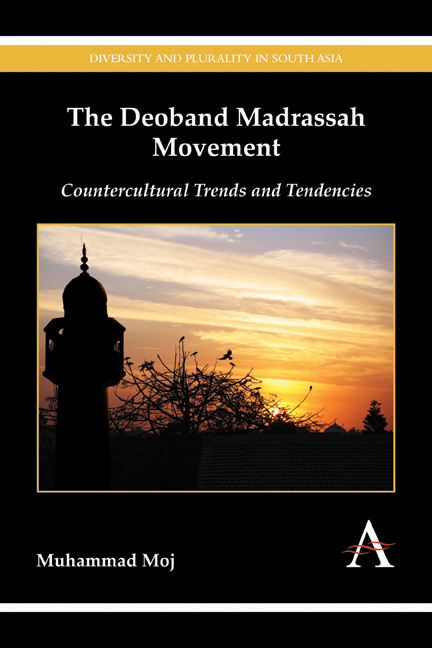Book contents
- Frontmatter
- Dedication
- Contents
- Preface
- Prologue
- Chapter 1 The Deoband Madrassah Movement: Research Context
- Chapter 2 Origin of the DMM: Seeds of a Counterculture
- Chapter 3 The DMM in United India: Activist Countercultural Trends
- Chapter 4 The DMM in Pakistan: Countercultural Politics and Extremism
- Chapter 5 Deobandi Islam: Countering Folk Islam and Popular Custom
- Chapter 6 The DMM versus Mainstream Society: Viewpoints of Deobandi Journals and Students
- Epilogue
- Appendix I The Deobandi Stance vis-à-vis Muslim Groups other than the Barelwis
- Appendix II Countercultural Exposition of the Deobandi Taliban
- Appendix III Interview Guide
- Glossary of Islamic Terms
- References
- Index
- Frontmatter
- Dedication
- Contents
- Preface
- Prologue
- Chapter 1 The Deoband Madrassah Movement: Research Context
- Chapter 2 Origin of the DMM: Seeds of a Counterculture
- Chapter 3 The DMM in United India: Activist Countercultural Trends
- Chapter 4 The DMM in Pakistan: Countercultural Politics and Extremism
- Chapter 5 Deobandi Islam: Countering Folk Islam and Popular Custom
- Chapter 6 The DMM versus Mainstream Society: Viewpoints of Deobandi Journals and Students
- Epilogue
- Appendix I The Deobandi Stance vis-à-vis Muslim Groups other than the Barelwis
- Appendix II Countercultural Exposition of the Deobandi Taliban
- Appendix III Interview Guide
- Glossary of Islamic Terms
- References
- Index
Summary
In most cases, a counterculture lacks the power to destroy its parent society.
Kenneth Westhues, Society's Shadow: Studies in the Sociology of Countercultures (1972, 34)Different scholars have interpreted the DMM from different perspectives. For some, it is an educational movement because it is based in madaris. Others consider it to be a religio-political movement as it hopes to establish an Islamic state in the subcontinent. Still others think that it is purely a religious movement involved in teaching religion and producing ulama to revive and spread Islam. The Deobandis themselves generally believe that their movement was launched to protect Islam and its teachings, which were under threat after the rise of British rule in India.
This book has endeavoured to interpret the DMM from a countercultural perspective by highlighting the presence of countercultural trends and tendencies in its 150-year-long history. The origin of the DMM is generally traced back to the eighteenth-century movement of Shah Waliullah, a broad-based Islamic revivalist movement with three components: intellectual, political and social. At the intellectual level, Waliullah's movement was originally a proponent of ijtihad and tatbiq (intellectual synthesis) of different viewpoints in Islam. The political component of the movement focused on the idea of establishing a model Muslim state in the subcontinent for the implementation of Islam. The social component of Waliullah's movement (which carried a relatively low priority and was largely considered part of the political component) was mainly concerned with purification of the norms and values of Indian Muslims in light of the practices of early Islam in Arabia. Another minor aspect of the social component was criticism of Shia Islam, although this was mostly underemphasized as Waliullah tried to find a common ground between Sunni and Shia Muslims.
When Waliullah's movement was passed on to the next generation of his family, its intellectual component suffered a setback owing to the absence of any scholar who could match the intellect and vision of the founder.
- Type
- Chapter
- Information
- The Deoband Madrassah MovementCountercultural Trends and Tendencies, pp. 195 - 202Publisher: Anthem PressPrint publication year: 2015



